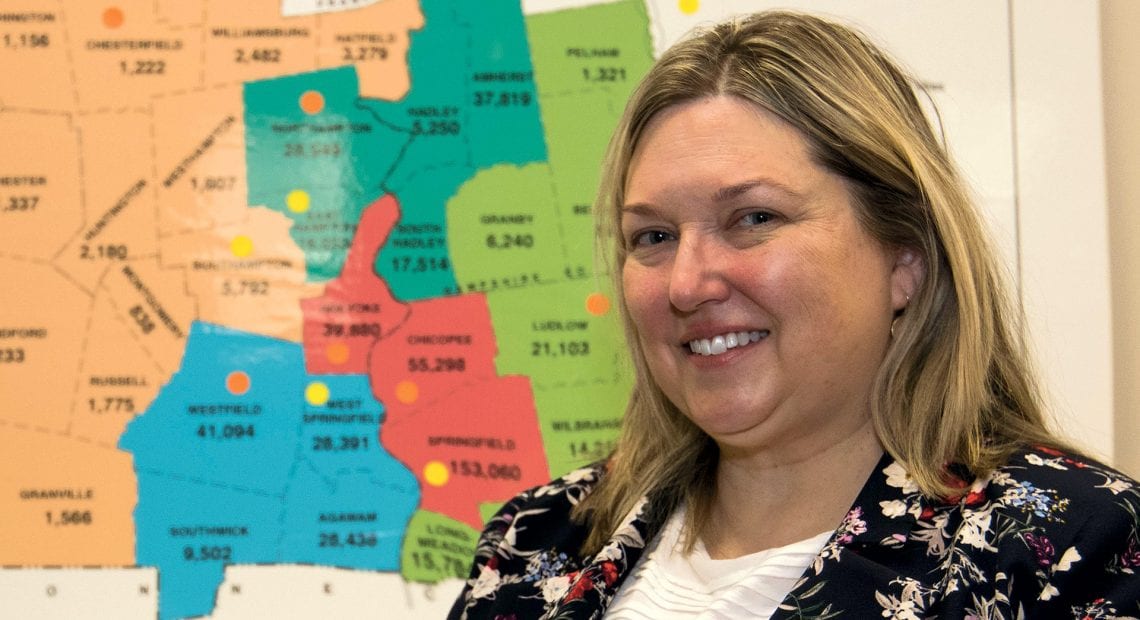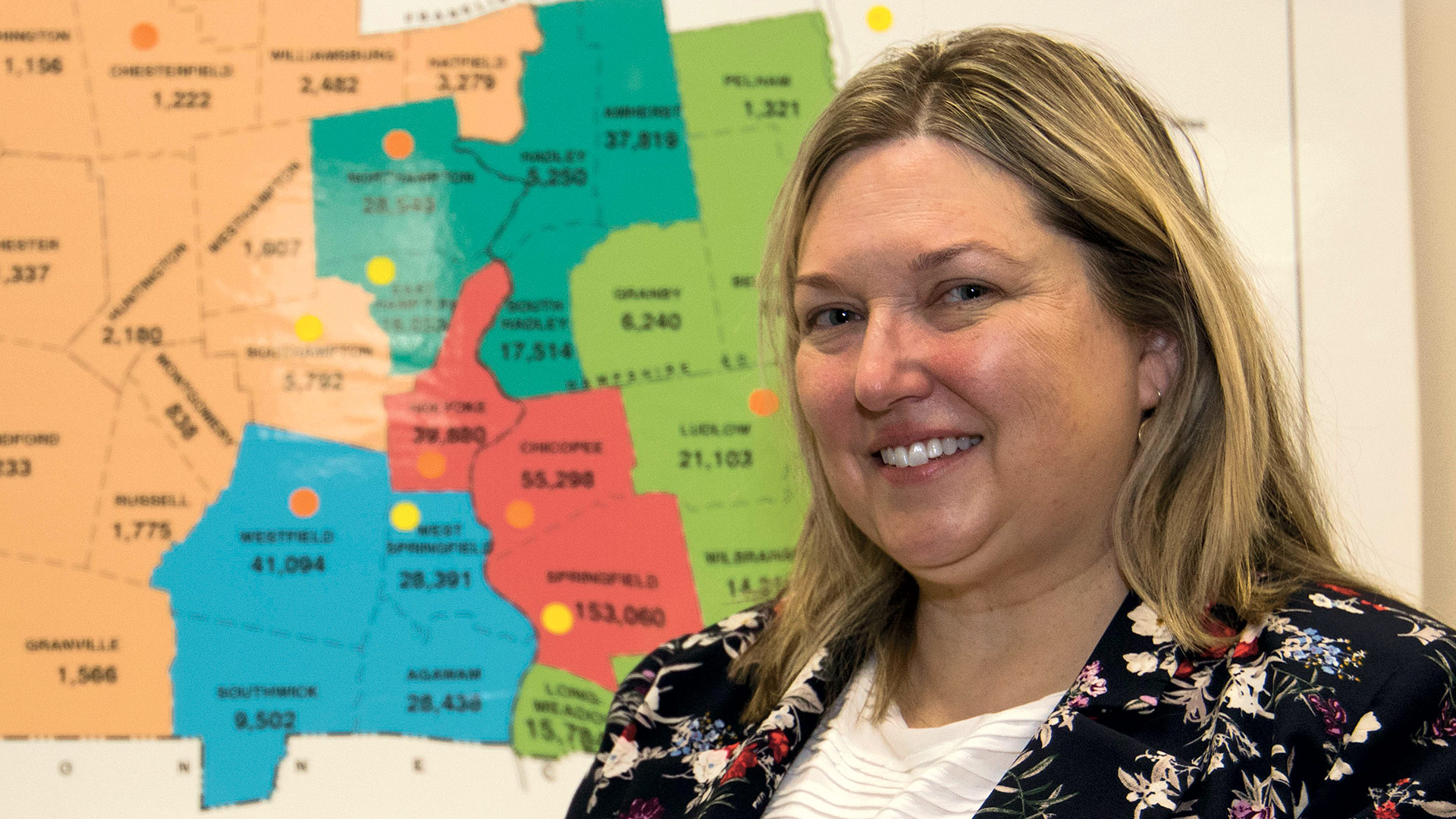
Kim Robinson Takes the Helm at the Pioneer Valley Planning Commission
Forward Thinking

Kim Robinson
Kim Robinson, who has worked with planning and development agencies in Detroit and Nevada, has been chosen to fill the large shoes left by Tim Brennan, who recently retired as director of the Pioneer Valley Planning Commission after more than four decades in that position. Robinson is focused on a number of short- and long-term priorities — everything from the upcoming census to east-west rail service.
Kim Robinson says she wasn’t exactly looking to move on from her job as executive director of the Truckee Meadows Regional Planning Agency in Reno, Nevada.
But then…
The advertisement posted on the jobs board on the American Planners Assoc. website caught her attention. And held it.
It was an ad seeking candidates to succeed Tim Brennan as executive director of the Pioneer Valley Regional Planning Commission, a post he held for more than four decades.
“ I saw this as a one-of-a kind opportunity. This seemed like a real opportunity to lead an organization that is so well thought of and has so many opportunities to help and support the 43 jurisdictions that are part of the area we serve. I could tell this was a special opportunity.”
Robinson, who moved into Brennan’s office just a few weeks ago, doesn’t recall the specific wording within that posting, but does recall what struck her eye and what prompted her to eventually move roughly 2,800 miles east.
“I saw this as a one-of-a kind opportunity, and I recognized that pretty early on in reading the job description itself,” she told BusinessWest. “This seemed like a real opportunity to lead an organization that is so well thought of and has so many opportunities to help and support the 43 jurisdictions that are part of the area we serve. I could tell this was a special opportunity.”
That area is Hampden and Hampshire counties, and those 43 jurisdictions are cities and towns as diverse as Springfield and Ware; Northampton and Longmeadow. For those communities, the PVPC, as it’s called, provides, as Robinson noted, a number of planning-related services.
Indeed, from its creation in 1962, the PVPC has been involved with everything from building bike trails to cleanup of the Connecticut River to creating the so-called Plan for Progress, a regularly updated document that has identified planning priorities for the region.
The specific list of services doesn’t go from A to Z, but rather from A to W, starting with air-quality analysis and ending with water-supply protection. In between lies everything from climate action and clean energy to housing planning and development to parking studies.
Meanwhile, the PVPC also provides what’s known as local technical assistance, or LTA, to member communities. It can take many forms, including information from the agency’s Data Center, traffic counts on local roads, and assistance with local grant applications.

Kim Robinson says one of many priorities for the PVPC, and the region, is expanding rail service to Springfield and other area communities.
It was the opportunity to be part of all that and write the next chapter in the agency’s history that prompted Robinson to go beyond reading the want ad and actively seek the position.
Since arriving, she has been busy on a number of fronts — from putting some of her own maps up on the walls of her office (like most planners, she has an affinity for maps) to meeting with many of the PVPC commissioners from those 43 cities and towns that are members; from getting a lay of the land, if you will, to setting some priorities for the short and long term.
In that first category is the upcoming national census and work to help ensure that as many area residents as possible are counted. An accurate count is important, she told BusinessWest, because the dollar figures attached to grants and assistance programs are driven by the numbers generated by the census.
“A lot of funding is derived from the census, so we obviously want as accurate a count as possible,” she said, adding that the PVPC has formed what’s known as a Complete Count Committee, or CCC, which utilizes local knowledge, influence, and resources to educate communities and promote the census through outreach efforts (more on that later).
Meanwhile, in that latter category are issues ranging from housing — specifically, the need to create more housing options, especially at the lower end of the price scale — to transportation and especially efforts to create more rail service and, in particular, an east-west line. And also something Robinson called ‘resiliency.’
This is an attribute the region and its individual cities and towns need to attain, she said, adding that there are many factors that can impact long-term resiliency, from jobs to climate change and efforts to control it.
“Resiliency is about an organization, or a community, being able to absorb changes that are kind of outside its control, whether it’s the economy or the climate or other factors — it’s the ability to be able to withstand and move forward,” she noted, adding that the goal moving forward is to make the 43 cities and towns in the region more resilient.
For this issue, BusinessWest talked at length with Robinson about her move across the country and what lies ahead for the region and the PVPC when it comes to planning and readying this area for what is to come in the decades ahead.
Background Discussion
Robinson brings a diverse background in planning and economic development to her new position with the PVPC, as well as experience working in different parts of the country.
Indeed, before relocating to Reno, she worked in Detroit, where she was born, starting in 1997 as a planner/administrator for the Jefferson-Chalmers District Council.
A year later, she became manager of the city’s Planning and Development Department, a post she stayed in for a full decade, an intriguing and challenging time for a city that fell into a serious spiral but in recent years has been on the rebound.
Early on in her Detroit tenure, the concept of empowerment zones was gaining traction, and Detroit was awarded $100 million for initiatives and departments.
“That provided an opportunity to do a lot of good, interesting work,” she recalled, “and there started to be a lot of growth and growth potential, and by the mid-2000s, we could really start to see the positive changes that were coming.”
Seeking a new and different challenge but in a somewhat familiar setting (she spent much of her childhood living in Southern Nevada), Robinson relocated to Reno and became Planning manager of the Washoe County Department of Community Development in 2007. Later, she would become executive director of the Truckee Meadows Regional Planning Agency, where she addressed a number of the same challenges she will encounter in Western Mass., including housing and the need to create more options at different price points.
Meanwhile, industrial land and, more specifically, challenges presented by its development, was another of the issues she and her agency addressed.
“The largest industrial park in the country is in the county next door,” she noted, referring to the Tahoe-Reno Industrial Center, a 107,000-acre facility that is home to more than 100 facilities, including the Tesla Gigafactory 1, a massive lithium-ion-battery and electric-vehicle assembly plant. “So the conversation around competition between the two counties was a large one. Meanwhile, one of the things we saw was a large number of jobs going to that county, but not a lot of homes being built. So the Washoe County area, all 6,000 square miles of it, which includes Reno and the city of Sparks, was responsible for providing housing, schools, education, all those pieces; it was a tremendous strain on the existing infrastructure, and they weren’t getting the tax dollars from that employment.”
Strategies for addressing these issues were part of the five-year regional plan for Washoe County that Robinson helped draft earlier this year. The ink was drying as she read about the job opportunity in the Pioneer Valley.
Robinson said she enjoyed her work in Western Nevada and, as she noted, wasn’t really looking for a new challenge, but that ad on the American Planners Assoc. job board changed that. Specifically, she recalled what the PVPC wrote with regard to what it was seeking in its first new executive director since Jimmy Carter was in the White House.
“They were looking for leadership, experience, and the opportunity to get some different perspective,” she recalled, adding that she was confident she could deliver all of the above, especially that ‘different perspective.’
Indeed, Robinson said she knew little, if anything about Hampden and Hampshire counties when she applied, but was intrigued by the agency, the depth of its portfolio of services, and the chance to lead such an organization.
While getting to know the region and some of the specific communities — she’s visited a few and plans to put a considerable number of miles on her car in the weeks and months to come — and also meeting with staff and having a few conversations with her predecessor, she is getting a handle on the issues confronting them. And in many respects, they’re the same as those she encountered in Nevada and Detroit.
Moving Targets
These include renewable energy (especially solar), housing, transportation, overall sustainability, and, yes, that all-important 2020 census.
Transportation, and especially efforts to expand and improve rail service, was Brennan’s pet project and one of his enduring legacies, said Robinson, adding that she understands the importance of passenger rail service to this area and its long-term prospects and intends to continue Brennan’s advocacy for additional service.
“We’ve just recently had a huge success with the start of the Flyer,” she said, referring to expanded north-south rail service on a line that extends from New Haven to Greenfield. “That’s a palpable piece of Tim’s legacy.”
As for the potential for east-west service that would link Boston and Springfield, Robinson said she’s among many eagerly awaiting the results of the state’s ongoing study of that concept.
But rail is just part of the larger transportation picture, she went on, adding that the PVPC is in the process of updating the Regional Transportation Plan, which will include discussion of streets, bike lanes, transit, “all the ways we move in our community,” she noted.
As for the census, it is an important priority for individual cities and towns and the PVPC, said Robinson, adding that the counts do far more than help determine how many congressional districts a state has and how they are drawn.
And the Complete Count Committee plays an important role in getting the numbers right.
“A lot of funding is derived from the census, so we obviously want as accurate a count as possible.”
“These committees present an opportunity to bring together all the various folks that are impacted by, or can help to impact, the census itself,” she explained. “We bring together a wide group of people — service providers, representatives of the cities and towns, the Census Bureau — and the conversation is about how we can get the most accurate and complete count possible.”
The upcoming census is an example of the many ways the PVPC assists local communities, and it also provides that local technical assistance, said Robinson, adding that this comes in a number of forms. As one example, she cited ongoing work with Longmeadow, which has requested assistance with its open-space and recreation plan, as well as frequent requests to help communities amend zoning bylaws.
The agency is also enjoying success with — and looking to perhaps expand — what it calls ‘shared services,’ such as accounting services provided by an individual hired by the PVPC that can be made available to smaller communities, thus saving them the expense of hiring someone themselves.
“It’s a great opportunity for them to save money because they’re buying along with others,” she explained, adding that other shared services include IT help and other areas; for example, at present, Longmeadow and East Longmeadow are having discussions about sharing a health director.
Moving forward, the PVPC will continually look for new and different ways to assist member communities, said Robinson, adding that the already-deep list and the potential to add to it was one of the many aspects of this job that caught her attention.
Toward Tomorrow
As she talked with BusinessWest in one of the conference rooms at PVPC’s headquarters on Congress Street in Springfield, Robinson said she doesn’t spend a lot of time looking at the APA jobs board and wasn’t necessarily looking to leave the Reno area.
“I applied for one job,” she explained.
It was a job she continually described as a one-of-a-kind opportunity, and for a number of reasons — but especially a desire to continue a nearly 60-year track record of service to the region, one that involves keeping one eye on today and the other squarely on tomorrow, meaning decades down the road.
That’s been the PVPC story, and Robinson is excited about the prospects of writing the next several chapters.
George O’Brien can be reached at [email protected]







